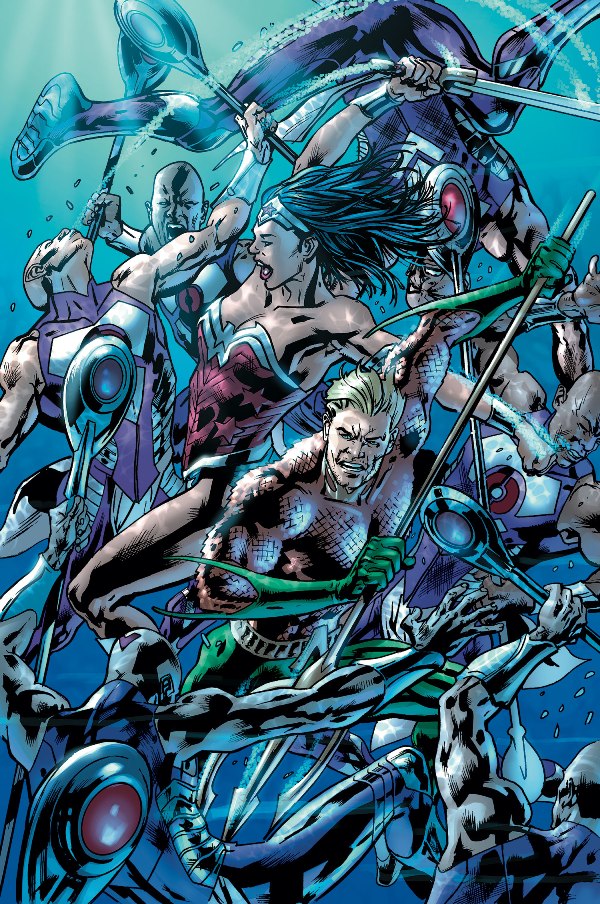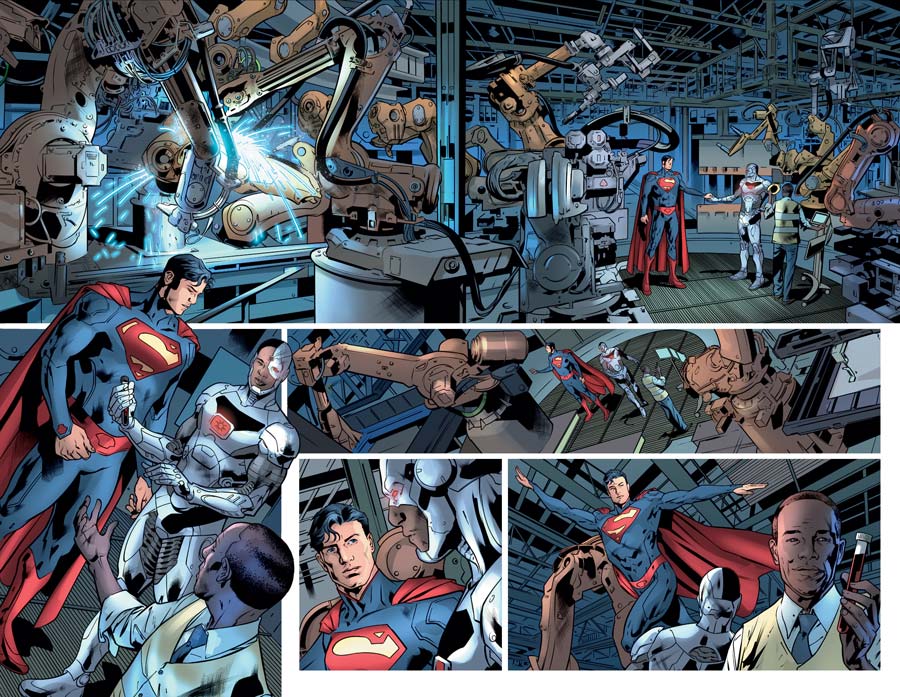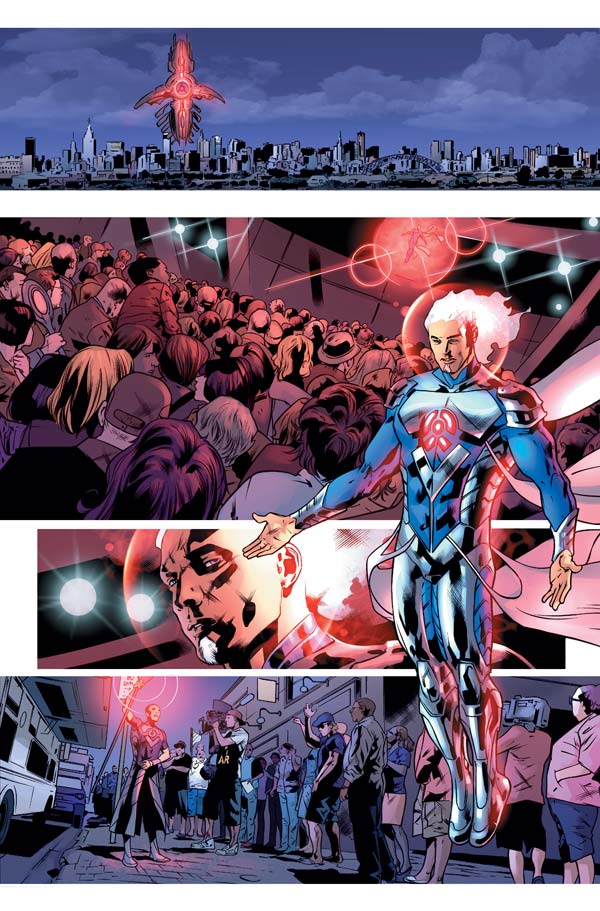What things come to mind when you think of Bryan Hitch? Big, intricately detailed panels. Massively scaled images and battle scenes. Action that blows you out of your seat. In other words, everything that makes Hitch such a perfect choice to write and draw the Justice League.
JUSTICE LEAGUE OF AMERICA was relaunched in June with Hitch at the helm, drawing this second Justice League ongoing as well as writing it. Now on its fourth issue, the series hasn’t disappointed fans hoping to see some of Hitch’s signature “widescreen” storytelling. However, the action has been driven by a story that’s also wonderfully thought-provoking, finding the League going head-to-head with a villain from Superman’s past that’s been embraced by the world for bringing it the very thing that Superman is supposed to stand for—hope.
With the latest issue in stores this week, we thought the time was perfect to sit down with this gifted writer and artist to discuss how this story came together, where it’s going and the organic way his ability as a writer is strengthened by his skill and experience as an artist.

So what’s going on right now in JLA for any readers out there who aren’t yet reading it?
So far what we have is a mysterious group called the Infinity Corporation who seem to be attempting to manipulate some event to do with Justice League. Superman’s Kryptonian god from ancient Krypton, Rao, has just shown up in this enormous cathedral-style spaceship hovering over New York and he’s converted the world, willingly, to his own religion. The world is following him, and he’s putting an end to conflict, hunger, disease and illness. Batman doesn’t trust him, while Flash and Green Lantern went missing in issue #1. Green Lantern suddenly showed up on ancient Krypton 250,000 years ago, and Flash is stuck in the 1960s inside the Infinity Corporation’s time traveling building. There are these three mysterious objects called “The Stones of Forever,” which seem to manipulate time. Oh, and Wonder Woman’s stuck on a destroyed Olympus.
That’s just so far!
You’re definitely giving the readers the sort of epic, large-scale story that fans expect from you. Was that the plan going in?
No, this is just me. This is natural. Dan DiDio had been talking to me for a couple of years after I left Marvel about coming over here and it just never seemed like the right project or the right writer. Things just never gelled. So he gave me the old, “All right, wiseguy, what would you do?” This is what I came up with. I put together a single-page document that had all the basics of this idea—Rao, the church, the big-scale conflict and the big ending that’s coming—and it was just like, “Right, off you go!”
So this is me doing what I do naturally. This isn’t me trying to do big-scale. But it’s also got an awful lot of small-scale character moments to because that’s what I like as well. You have to have that.
One of my kids was asking me which Justice Leaguer was the team leader, and I said there isn’t one. There are seven of them. These are all seven alpha beings. They’re all in charge. They’re all experts. They’re all good at what they do, and they all know that about each other. So there will be moments where in a scene Batman leads, or Superman leads, but they’re leading a scene or a moment. They’re not leading a team.
Is that one of the reasons you had the big foldout variant cover?
No, that was because I wanted to draw a really big cover! Actually, I did this little sketch of the foldout and I asked Dan if we could do this. I expected him to wholly say no. I did the eight-page spread in Ultimates, and I thought, “This is the Justice League. Can I do another eight-page spread?”
But I had no idea that they’d say yes. That was just because I wanted to draw it. That’s the only reason for that one.

You’re writing this series as well as drawing it. How much writing had you done prior to this?
This isn’t an evolution that started two years ago. This has been happening for 20 years. When I got into comics it was to tell stories, and I wanted to write as much as I wanted to draw. But I was being told to focus on the drawing and all the improvements I’ve tried to make as an artist have been focused on how to tell a story better. If you can draw anything, then your storytelling is unlimited—your options are unlimited.
I wouldn’t want to spend my career drawing or painting covers—that wouldn’t interest me. What interests me is telling stories. When I worked on The Ultimates, I noticed that the buying public and the reviewers often think that because you’ve drawn it, then it must have been in the script for you to draw. It doesn’t work like that. Sometimes you have a relationship like I had with Mark on The Ultimates. He’d often say that The Ultimates were 75% me and nobody believed him because he was the writer and I was the artist and that’s how people break it down. So any expression on a character or anything the characters do had to have been in the script, and it just didn’t work that way.
I wrote a six-issue Ultimate Cap series for Marvel toward the end of my run there and I got pulled off that after drawing the first few pages to draw Age of Ultron. So that never got published even though I fully wrote all six issues. I’ve also written and co-written creator-owned stuff, so it’s not an immediate evolution. This has been happening for a long part of my career.
From all I’ve heard, it can be very difficult to write a “team book” like Justice League of America. Is that something you’ve found?
No, but I’ve been drawing team books and co-writing/co-plotting team books for a long time. I understand the dynamic very well. That’s something that’s just in my DNA now.
One thing that stands out to me in your story is the religious aspect. As you mentioned, people are willingly embracing Rao’s religion. Was that just something that seemed cool, or were you looking at where we are as a society right now?
I grew up as part of a very strict Catholic family. I even went to seminary to study for the priesthood before, as I keep saying, I discovered Superman was cooler than God. Religious fundamentalism is causing the loss of lives at a large scale. Historically, religion has caused the loss of lives. That’s the way the world is, but people are always looking for a place to belong that’s outside of just the immediate family. They want to find ways to understand the world or to get comfort from the horrors of the world. Religion offers that to a lot of people. I can appreciate why people want to believe in an afterlife or a higher purpose. But they also want their problems solved for them. They don’t want to be hungry, poor or ill, and religion often offers a way for people to either understand that which they can’t control or a prayer that allows you to think you can control it by asking for intervention.
But what if that was real? There are gods in the DC Universe. Wonder Woman is the god of war. But what if somebody that represents the idea of the Christian god—the idea of that kind of messiah who heals the sick, feeds the hungry and ends conflict—what if that was real? What would that do to a society like ours? Would we be better off as people? What if the people of the planet actually like what Rao’s doing? If he’s gone, is that a good thing for them?
That provides you with a potential bad guy that has a rationale that you can understand and actually find yourself agreeing with. When he has a conversation with Superman about what he’s bringing to the world, you have to believe him because he is doing these things. He is right. But there’s kind of a counterpoint for what he’s bringing in that obviously he needs to get something out of it as well, and he does. That’s one of the things that happens in issues #4 and #5. But again, it’s still a cost I think a lot of people in our real world would be willing to pay to have the kind of life that he’s offering. So again, it’s not a clear cut story. It’s not a case of Darkseid showing up to conquer the world. This is the world willingly giving itself to Rao.

You end up with a story where the Justice League finds itself at odds with the desires of the people they’re trying to protect. Is that where it becomes really interesting to write characters like the ones in the Justice League?
Yes, it is. It takes them from that kind of black and white area, and that’s an interesting way of looking at those classic super heroes. They know that they’re fighting for what they think is a greater good, but you might not think that when you read the story. I like the idea of being able to put that out there and say that the heroic ideal maybe isn’t as clear cut as we’d like it to be because it isn’t that kind of world we live in.
So is there a Justice Leaguer you like drawing the best?
There isn’t, actually. I thought I’d have more trouble writing and drawing Batman. That was the one I was really worried about. But he’s sort of taken care of himself. I find him absolutely hilarious. In fact, I was writing this scene between Aquaman and Batman that dealt with magic crystals, and just the two of those guys being aware of the absurdity of talking about magic crystals, but actually having to go through the mechanics of that scene, discussing the properties of the magic crystals and how to use them. The undercurrent in that scene is just hilarious. That was a huge surprise to me that you’d get Batman having one-liners.
But no, I’m just having such a good time as a whole on this that there isn’t a single character that stands out. I could see this thing running and running where you have different arcs led by different characters. Obviously, Superman is the entry point for the Rao storyline. I could see that happening with each member of the group, at least once. Then do it twice and you have a hundred issues!
We’ve discussed how the story informs the art and using art to effectively tell the story you want to tell, but are there times where there’s just something you really want to draw that you find yourself working it into your story?
Well, that goes back to what I said earlier about how I’m driven by storytelling and not by, “Wouldn’t it be cool if I drew this?” The thing that excites me about drawing is thinking of story elements, then I really can’t wait to draw those scenes, moments or action sequences. I’ve said this in other places that I actually find drawing to be the hardest part of the job. You’ve got to sit there for seven or eight hours per page, at least, and just do all the work and details. That doesn’t interest me. I’m not actually that fond of drawing.
Though Adam Hughes once said to me that I must be really fond of drawing if I’m spending that much time putting all the details in. I realized that there’s obviously something wrong with my psyche! But it’s the storytelling that’s the passion. The drawing is what I have to do in order to be able to tell stories, which is why I work so hard on trying to improve my skills as an artist. It gives me more and more options as a storyteller. If your storytelling is limited by what you can draw, then you can’t tell a story as well as you might need to be able to.
For people who aren’t reading your series, why should they check it out?
Because it’s cool! It’s got all the core characters, action on a colossal scale and you don’t need to have read any of the other books to enjoy it. It’s like a blockbuster comic book HBO TV series. That’s what it is really. It’s not a movie, it’s an HBO series with an unlimited budget.
JUSTICE LEAGUE OF AMERICA #4 by Bryan Hitch, Daniel Henriques and Alex Sinclair is now available in print and as a digital download. For more from Bryan Hitch, be sure to check out his exclusive DC All Access artist commentary clip.




















